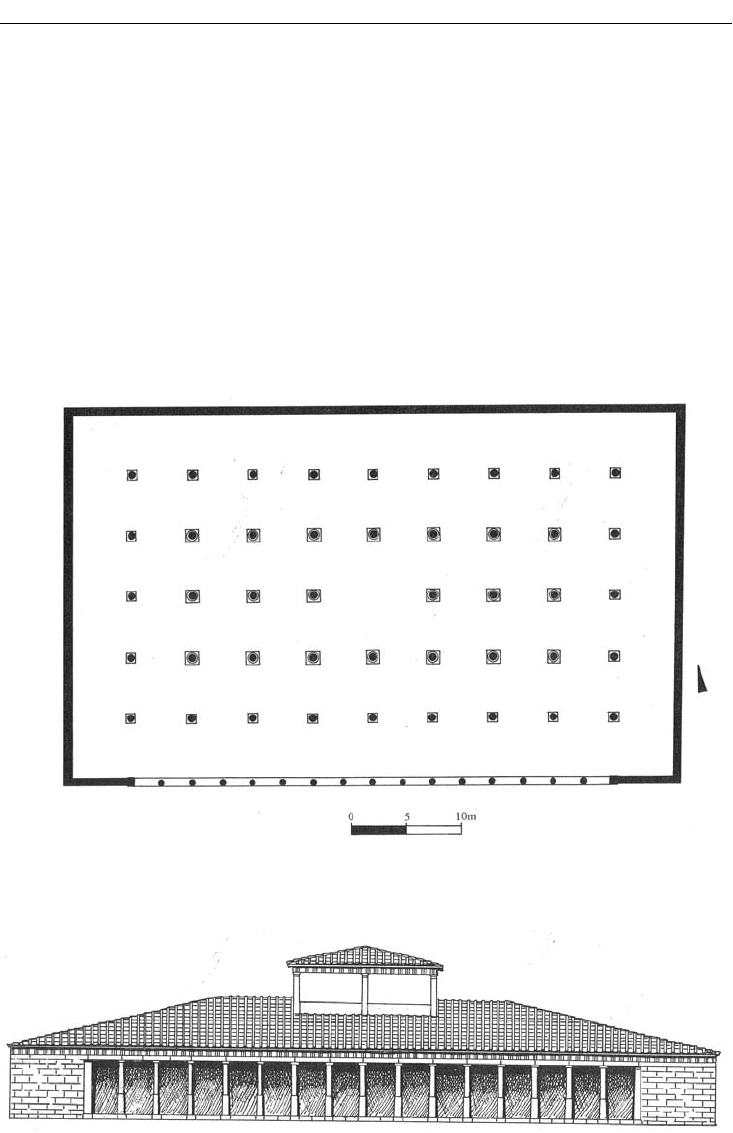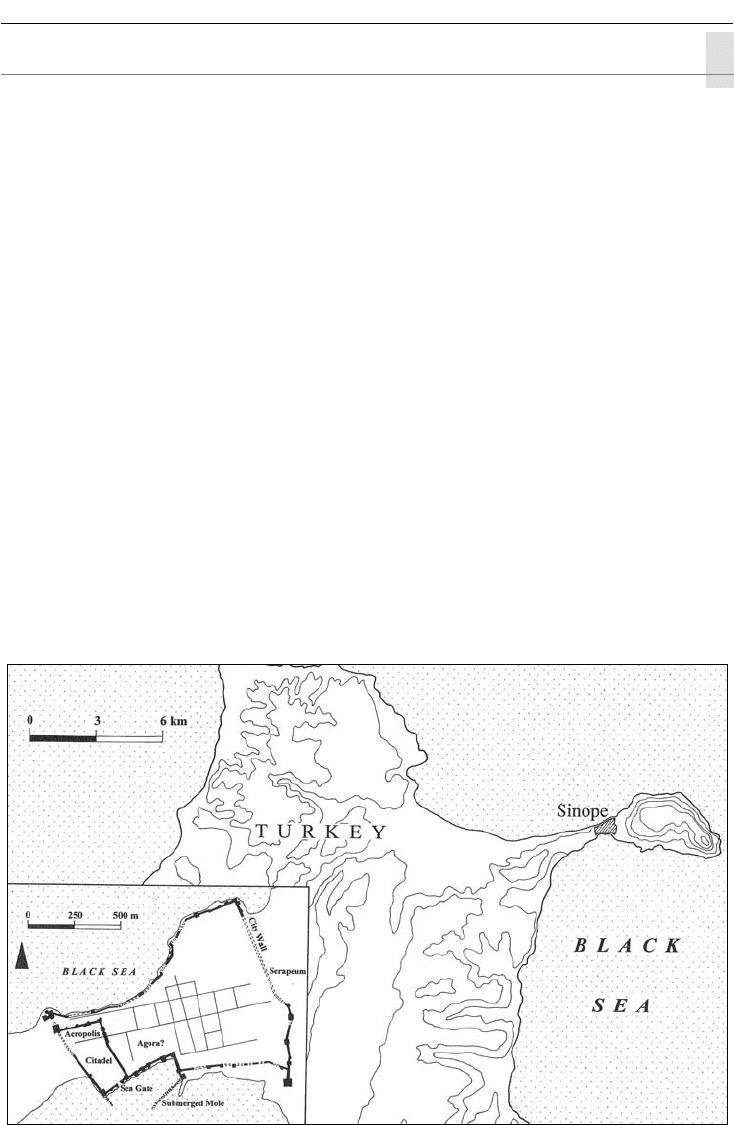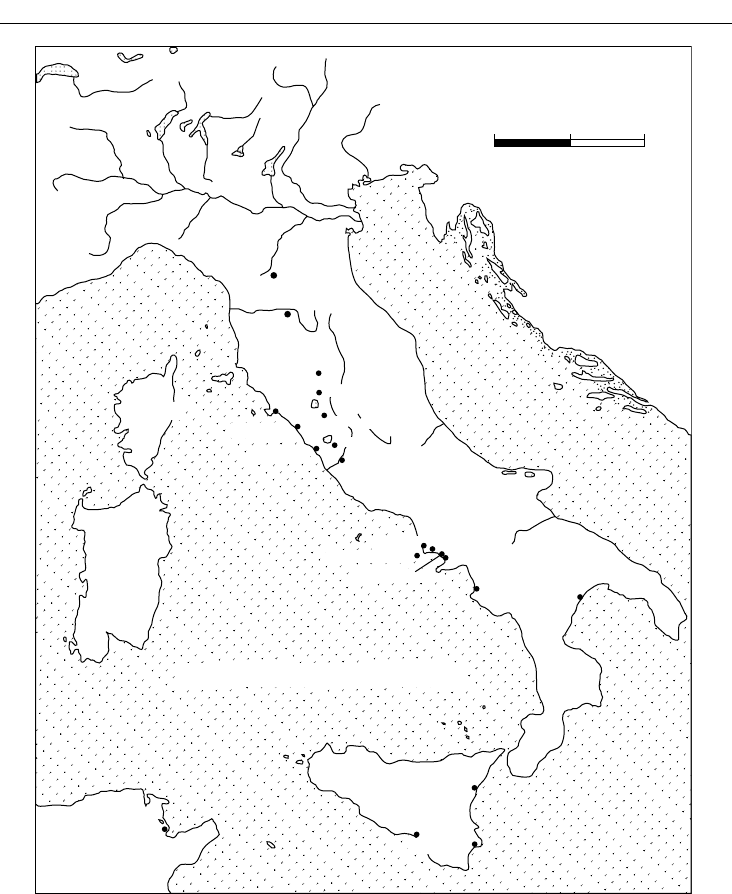Gates Charles. Ancient Cities: The Archaeology of Urban Life in the Ancient Near East and Egypt, Greece and Rome
Подождите немного. Документ загружается.


302 GREEK CITIES
Certain houses of the Hellenistic period are particularly magnificent, with peristyle courts deco-
rated with fine mosaics. But life here was fragile: on this waterless island survival depended on
careful collection of rainwater in cisterns underneath the courtyards.
The commercial buildings consisted notably of warehouses and agoras. As large spaces both
covered and uncovered, such architecture rarely gives clues as to the precise activities that
went on inside them. At Delos we are much helped by inscriptions, which mention (often in
fragmentary form) who was doing what, but even they only infrequently answer the questions
we might like to ask. For example, where were the thousands of slaves bought and sold? We
do not know, for any of a number of spaces might have served the purpose. Warehouses lining
the shore south of the harbor are good candidates, for they are separated from the residential
neighborhood behind by a wide street, a possible division between the transient commerce
coming and going by sea and the permanent housing behind. Less likely, perhaps, is the Stoa
of Poseidon or Hypostyle Hall (modern name) of the late third century BC (Figures 18.12 and
Figure 18.13 Hypostyle Hall (reconstruction), Delos
Figure 18.12 Plan, Hypostyle Hall, Delos

HELLENISTIC CITIES 303
18.13). Its architecture is unusual and puzzling: its precise function is unknown, although it has
been classified as a commercial building. A large covered hall, it measures 65.45m × 34.30m.
Solid walls form three sides and turn into the fourth, where a line of fifteen Doric columns
form a broad entrance. Inside, the hipped roof is held up by forty-four columns, arranged
nine columns in five rows, with no column in the center. The outer twenty-four are Doric, the
taller, inner twenty Ionic; the eight central columns, forming a square, held up a lantern with
a clerestory, for illumination. A clerestory is a section of a building that rises above adjacent
parts; the higher walls carry windows, bringing light into the interior. We met the clerestory in
Egyptian houses and the Hypostyle Hall at Karnak, and we will see it again in the basilicas of
Roman architecture and of Early Christian church architecture.
The agoras, open-air squares, have often been cited as places where slaves were traded. But this is
only a possibility, not proven. Clearly commercial centers, the agoras tend to be filled with religious
items, such as altars and shrines, but this reminds us of the religious atmosphere in which business
was conducted in Hellenistic Delos. In the absence of a strong governmental authority, the gods
were invoked as witnesses; transactions were always sealed with oaths sworn to the gods.
The largest agora of Delos, the Agora of the Italians, lacking the religious features seen in
other agoras, must have served a different purpose. Built in the late second century BC, this agora
consists of an irregular rectangle, roughly 70m × 50m, lined with a portico of 112 Doric columns
(Figure 18.14). Beyond the portico lay alcoves. Shops were entered from the outside, thus sepa-
rated from the functions of the interior of the agora. Could this be a center for the slave trade?
Evidence is not forthcoming. Instead, equipped with a palaestra and bath for sports, a space
usable for the gladiatorial combats Romans enjoyed watching, and possibly a banquet hall, this
agora may have been a clubhouse and recreational facility for the Italian community on Delos.
With an entry through a single propylon, the walled space looks defensible too, a consideration
that may have interested a minority community far from home. If so, the agora may well have
been put to the test in 88 BC, when the soldiers of Mithridates VI attacked, massacring the Italians
in the eastern Aegean. After the defeat of Mithridates and the reassertion of Roman power, the
agora was repaired, but then was finally abandoned in 60–50 BC as Delos fell into decline.
Figure 18.14 Plan, Agora of the
Italians, Delos

304 GREEK CITIES
Figure 18.15 Sinope in its larger landscape, and city plan (insert)
SINOPE: A PORT ON THE BLACK SEA
Let us end with a more modest city, yet one with a distinguished and fascinating history: Sinope
(modern Sinop), on the south coast of the Black Sea. Founded by colonizers from Miletus in
the late seventh century BC, according to the match of literary testimony with the earliest datable
finds of Greek pottery, Sinope is located on a dramatic peninsula that juts out to the east like a
hook, offering a protected harbor on its south side. The tip of the peninsula rises high like an
island; Sinope, ancient and modern, lies on the isthmus just to the west (Figure 18.15). The city’s
hinterland, a narrow coastal strip, allows for some agriculture; olive oil was a significant export.
Other valuable resources included timber from the mountains and sinoper or miltos, a type of
red ochre used in paints and in shipbuilding. In addition, fishing has always been an important
element in the economy. Thanks to the great rivers that pour into the western and northern Black
Sea – the Danube, Dnieper, and Don – the Black Sea has been an excellent environment for fish,
although in modern times industrial pollution carried by these same rivers has caused damage.
Ancient Sinope owed its prosperity to its geographical location, centrally placed on the Black
Sea’s southern coast, propitious for trade and communication by sea with other communities
in the Black Sea basin. Land connections, however, were poor. The Pontic mountains that run
east–west across northern Turkey are high and close at hand, preventing easy contact with the
plateau to the south. The coastal strip itself is broken periodically by mountains that descend to
the sea. The easiest method of communication was by boat, a situation that changed only in the
mid- to late twentieth century when asphalted roads were blasted through. Sinope did, however,
pay attention to the coastal region. Itself a foundation, it founded in turn its own colonies along
the coast, all contributing to its prosperity during Greek and Roman antiquity, into the early

HELLENISTIC CITIES 305
fourth century AD. The three main colonies to the east – Kotyora, Kerasous, and Trebizond,
modern Ordu, Giresun, and Trabzon – are still today prominent cities of the region.
Geographically close to the Crimean peninsula to the north, the city benefited also from cur-
rents in the sea, which allowed for an easy passage across the middle of the Black Sea. Indeed,
it was this location, the connection with Greek cities in the Crimea and elsewhere in the north,
that allowed this port to flourish as the main shipping center for the Black Sea during classical
antiquity and even later, in medieval times. In the nineteenth century, though, technological
developments led to its isolation. The steamship, not dependent on winds and currents, permit-
ted direct communication between Constantinople, Odessa, the Crimea, and Trabzon, the thriv-
ing mercantile centers of the time.
Sinope figures regularly in the historical texts of the ancient Greeks and Romans. Autonomous
through the rule of the Persians and during the early Hellenistic period, Sinope was captured in
183 BC by Pharnaces I, king of Pontus. The Kingdom of Pontus had been established around
300 BC in north central Asia Minor, straddling the Pontic mountains, one of the many states that
emerged in the conflicts following the death of Alexander the Great. After 183 BC, Sinope would
serve as a new capital of this kingdom, along with Amaseia, in the interior. As such, it became a
target during the bitter struggle between Mithridates VI and the Romans in the first half of the
first century BC. After capturing and sacking Sinope in 70 BC, the Romans soon resurrected the
city, granting it autonomous status. As a designated Roman colony, Colonia Julia Felix Sinopen-
sis, a status arranged by Julius Caesar in 47 BC, it would prosper through the imperial centuries.
Little remains from the ancient city. The geographer Strabo, himself a native of Amaseia,
described the city as follows: “The city itself is beautifully walled, and is also splendidly adorned
with gymnasium and marketplace and stoas” (Bryer & Winfield 1985: 69). These well-built walls
still survive, giving a good sense of the area of the ancient city (Figure 18.15). They may date
originally to the second century BC, when Sinope became the capital of Pontus. The western sec-
tion includes a citadel, used in modern times (1887–1997) as a high security prison, but now open
to the public. As for the layout of the city, a grid plan seems to have been applied, if the modern
street plan can be considered a reflection of the ancient. Hippodamus, the fifth century BC city
planner, was from Miletus; it has been conjectured by Bryer and Winfield that this Milesian spirit
had influence here, in this colony of Miletus, even several centuries after the initial connection.
Other ancient remains include foundations of a temple attributed to Serapis, dated to the second
century BC, and traces of the mole in the southern harbour. Of Strabo’s gymnasium, marketplace,
and stoas, nothing remains.
A new perspective on Hellenistic Sinope has been given in recent years by the exploration of
amphorae workshops. Conducted in the 1990s by French teams in cooperation with the Sinop
Museum, these excavations revealed the active production in Sinope and vicinity of ampho-
ras, ceramic storage jars that would be filled with olive oil and wine and shipped throughout
the Black Sea, especially to communities on the northern shores. The remains of kilns and the
finds of wasters (pieces of pottery that were broken, misshapen, or over-fired) have clarified the
manufacturing process. The dating of the workshops comes in particular from finds of stamped
amphora handles (see above, Chapter 17). At Sinope, the stamp indicated the name of the annual
magistrate, the name of the manufacturer, and an emblem related to the official or the producer.
Specialists can date these stamps to within a range of ten years. Some 20,000 stamp impressions
from vases originating in Sinope have been discovered, mostly in the Black Sea area, a valuable
source of information concerning the commercial networks crucial for the economy of the city.

PART THREE
CITIES OF ANCIENT ITALY AND
THE ROMAN EMPIRE

CHAPTER 19
Greek and Etruscan cities in Italy
In the later first millennium BC, the center of power in the Mediterranean basin shifted westward
to the city of Rome. Rome was established as a permanent settlement during the early Iron Age,
but several centuries passed before this village grew to regional and international prominence. As
it developed, the Roman state borrowed from, then conquered, two urban cultures well estab-
lished on the Italian peninsula beginning in the early Iron Age, the Greek (in south Italy and on
Sicily) and the Etruscan (centered in Etruria, largely modern Tuscany, north of Rome). Other
cultures encountered and absorbed would exert less tangible influence: Phoenician settlements
in western Sicily, Sardinia, coastal Spain, and North Africa, of which the greatest was the city of
Carthage near modern Tunis (see Chapter 11); and several rural, regional cultures in Italy and Sic-
ily. Before we turn to Rome itself, let us examine the urban achievements of the first mentioned,
the western Greeks and the Etruscans, keeping in mind their place in the culture history of the
Mediterranean basin and their legacy to the Romans (Figure 19.1).
GREEK CITIES IN SOUTH ITALY AND SICILY:
PAESTUM AND SYRACUSE
Greek colonization of the Italian peninsula and Sicily began in the mid-eighth century BC,
according to the assertions of such later Greek historians as Thucydides (later fifth century BC)
and to discoveries of Greek pottery of the geometric style on urban sites in Italy. The Greeks
did not step into the unknown; instead, these towns represented a new chapter in ongoing
trans-Mediterranean trade relations, developed notably by the Phoenicians. The earliest such
settlement was established by Euboean Greeks at Pithekoussai on the island of Ischia near mod-
ern Naples. Other foundations quickly followed, with Kyme (Cumae) on the Italian mainland
opposite Pithekoussai and Naxos on the east coast of Sicily among the earliest; the latest
colonies were established in the fifth century BC. The Greeks stayed on the coastal plains, thus
minimizing confrontations with local peoples. A rural area for agriculture, precisely delimited,
surrounded the town; the countryside contained important religious sanctuaries as well as farm-
houses. As for the broad limits of their territory, the Greeks did not seize land north of Naples,
Greek settlements in South Italy and Sicily: eighth to third centuries BC
Syracuse captured by the Romans: 212 BC
The Etruscans: flourished from the eighth
to second centuries
BC

310 ANCIENT ITALY AND THE ROMAN EMPIRE
no doubt because it fell within the hegemony of the powerful Etruscans (see below), nor did they
settle in western Sicily and Sardinia, areas already claimed by the Phoenicians.
Important colonizers included the island of Euboea and the cities of Corinth, Megara, and
Miletus; Athens and Sparta surprisingly founded only a few. Reasons for this great wave of
emigration to south Italy, Sicily, and elsewhere (notably the Black Sea region) include over-
population and consequent food shortage in the homeland; an escape for political dissidents in
societies in ferment; and a sense that Greek life could be effectively conducted, even thrive, on
distant soil. Institutions were similar, with west Greek cities organized as poleis, self-governing
Figure 19.1 Italy and the central Mediterranean
ALPS
Po River
Arno
Tiber
ALPS
Marzabotto
Florence
APENNINE MTS.
ETRURIA
Chiusi
Cosa
Orvieto
Rome
SARDINIA
Naples
Pompeii
Paestum
Metapontum
Naxos
Gela
Carthage
SICILY
LATIUM
C
A
M
P
A
N
I
A
MEDITERRANEAN SEA
Cumae
Pithekoussai
Herculancum
0 200 400km
CORSICA
Tarquinia
Cerveteri
Veii
Acquarossa
Syracuse

GREEK AND ETRUSCAN CITIES IN ITALY 311
city-states. In contrast, tyrannies dominated, democracy never gaining a solid foothold. Relation-
ships with the founding, or mother, cities were normally strong, but it is important to note that
the new towns were not satellites of the founding cities but instead enjoyed complete indepen-
dence. Prospering especially from agriculture but also from trade, the Greek cities of south Italy
and Sicily made their mark in the Mediterranean and were accepted as full-fledged members
of the Hellenic world. Indeed, we have already encountered an important sculpture group
dedicated by a Sicilian Greek at the Panhellenic sanctuary at Delphi: the “Charioteer of Delphi,”
the gift of Polyzalos, tyrant of the city of Gela, after his victory in the chariot races in the Pythian
Games at Delphi in either 478 BC or 474 BC (Figure 15.5).
The history of the western Greeks differed somewhat from that of Greeks to the east. They
did not have to face the threat of Persian invasion. But Carthage was a perpetual menace, and the
region, lying between Carthage and Rome, suffered during the ongoing conflict between these
two cities, the Punic Wars (264–146 BC). The Greek cities gradually fell to the expanding Roman
Republic, the takeover completed with the Roman capture of Syracuse in 212 BC. At least on
Sicily, however, Greek language and culture continued until the Arab invasion of the island in
the ninth century AD.
Paestum (Poseidonia)
Poseidonia, generally called by its later Roman name of Paestum, is the best known of the Greek
cities on the Italian peninsula, thanks to four well-preserved monuments: three temples of the
sixth and fifth centuries BC and the figural paintings from the Tomb of the Diver. Serious explo-
ration of the site began in the eighteenth century, with excavations conducted throughout the
twentieth century primarily by Italian archaeologists.
Founded ca. 600 BC by migrants from the south Italian Greek colony of Sybaris, Poseidonia
was located on a low ridge just inland from the modern coastline in an area with scant traces
of previously existing inhabitants. The attraction was fresh water and good farm land. In the
absence of a natural anchorage, ships were simply hauled up onto the beach. For two centuries
the city remained Greek; democracy developed here, as a bouleuterion discovered in the agora
attests. In 400 BC, the Lucanians, an Italic people based in the interior, captured the city. The
Romans absorbed the town in 273 BC, establishing a Latin colony and changing its name to Paes-
tum. Decline soon set in. A major north–south road built in 133 BC, the Via Popilia, bypassed
Paestum, and cities in the Bay of Naples (60km to the north) became the prosperous centers for
maritime trade. The silting up of local streams caused flooding and created malarial swamps.
During the later empire population declined, and by the seventh to ninth centuries AD settlement
had shifted completely to the healthier hills inland.
Aerial photos have shown that in the Roman period, at least, the city was laid out according
to Hippodamian principles, with parallel streets crossed by others at right angles (Figure 19.2).
A 4.8km-long fortification wall, originally Greek, enclosed the city, with four main gates roughly
aligned with the compass points. Although the sixth-century BC plan of Poseidonia is not known,
it has been assumed that the early city was similarly organized in a grid. Such a plan is known from
surveys conducted at sixth-century BC Metapontum, another Greek colony in south Italy, and
seems characteristic of layouts of cities newly founded on flat ground. The orientation of Greek
Poseidonia’s plan must have differed from the Roman, however, for the north and south city
gates and the three great pre-Roman temples form a line that deviates from the Roman grid.
The three Archaic and Classical temples, built in the Doric order favored in west Greece, are
among the best preserved anywhere in the Greek world (Figure 19.3). Despite general confor-
